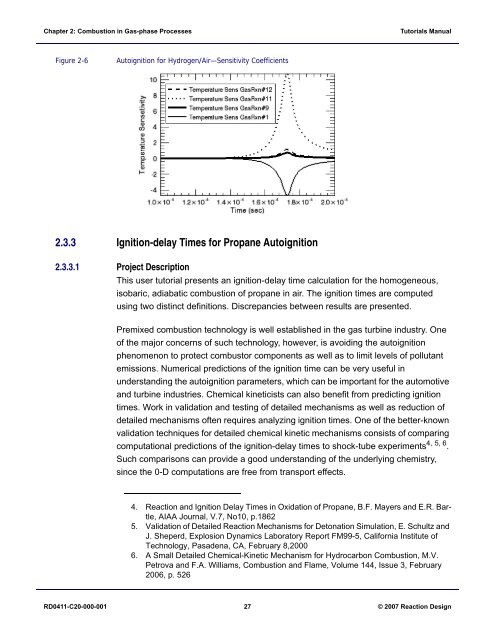Tutorials Manual
Tutorials Manual
Tutorials Manual
You also want an ePaper? Increase the reach of your titles
YUMPU automatically turns print PDFs into web optimized ePapers that Google loves.
Chapter 2: Combustion in Gas-phase Processes<br />
<strong>Tutorials</strong> <strong>Manual</strong><br />
Figure 2-6<br />
Autoignition for Hydrogen/Air—Sensitivity Coefficients<br />
2.3.3 Ignition-delay Times for Propane Autoignition<br />
2.3.3.1 Project Description<br />
This user tutorial presents an ignition-delay time calculation for the homogeneous,<br />
isobaric, adiabatic combustion of propane in air. The ignition times are computed<br />
using two distinct definitions. Discrepancies between results are presented.<br />
Premixed combustion technology is well established in the gas turbine industry. One<br />
of the major concerns of such technology, however, is avoiding the autoignition<br />
phenomenon to protect combustor components as well as to limit levels of pollutant<br />
emissions. Numerical predictions of the ignition time can be very useful in<br />
understanding the autoignition parameters, which can be important for the automotive<br />
and turbine industries. Chemical kineticists can also benefit from predicting ignition<br />
times. Work in validation and testing of detailed mechanisms as well as reduction of<br />
detailed mechanisms often requires analyzing ignition times. One of the better-known<br />
validation techniques for detailed chemical kinetic mechanisms consists of comparing<br />
computational predictions of the ignition-delay times to shock-tube experiments 4, 5, 6 .<br />
Such comparisons can provide a good understanding of the underlying chemistry,<br />
since the 0-D computations are free from transport effects.<br />
4. Reaction and Ignition Delay Times in Oxidation of Propane, B.F. Mayers and E.R. Bartle,<br />
AIAA Journal, V.7, No10, p.1862<br />
5. Validation of Detailed Reaction Mechanisms for Detonation Simulation, E. Schultz and<br />
J. Sheperd, Explosion Dynamics Laboratory Report FM99-5, California Institute of<br />
Technology, Pasadena, CA, February 8,2000<br />
6. A Small Detailed Chemical-Kinetic Mechanism for Hydrocarbon Combustion, M.V.<br />
Petrova and F.A. Williams, Combustion and Flame, Volume 144, Issue 3, February<br />
2006, p. 526<br />
RD0411-C20-000-001 27 © 2007 Reaction Design
















